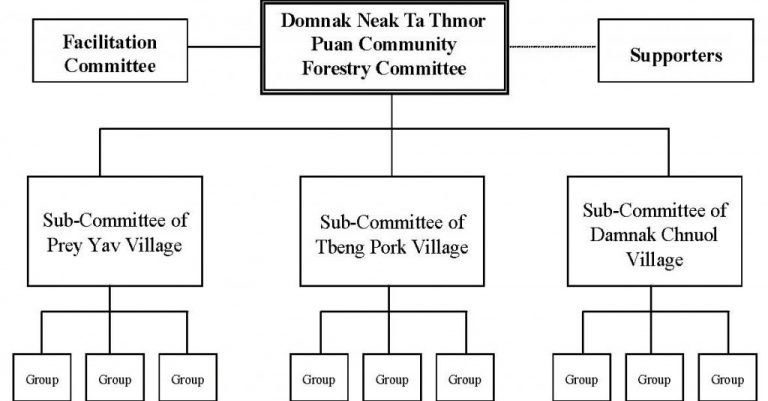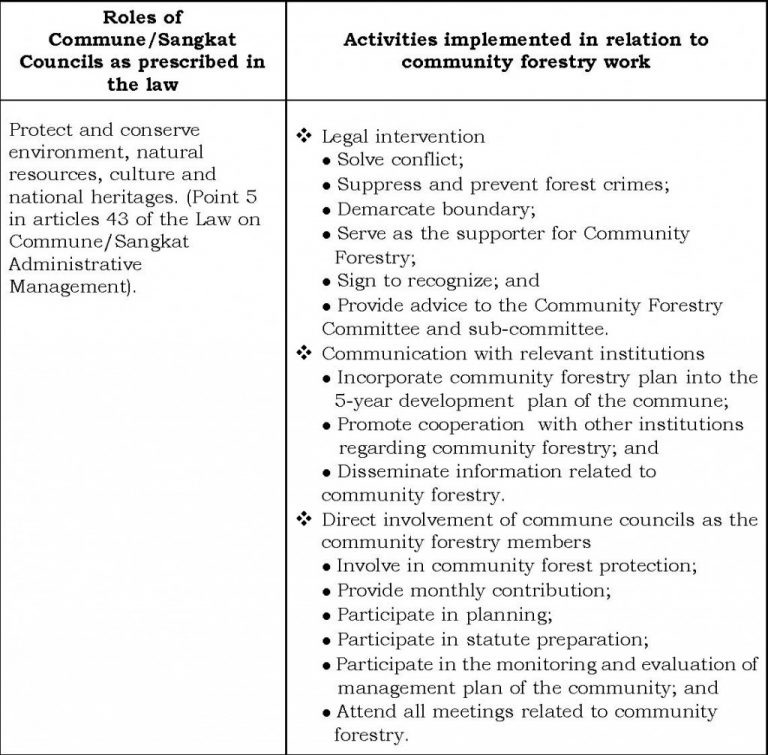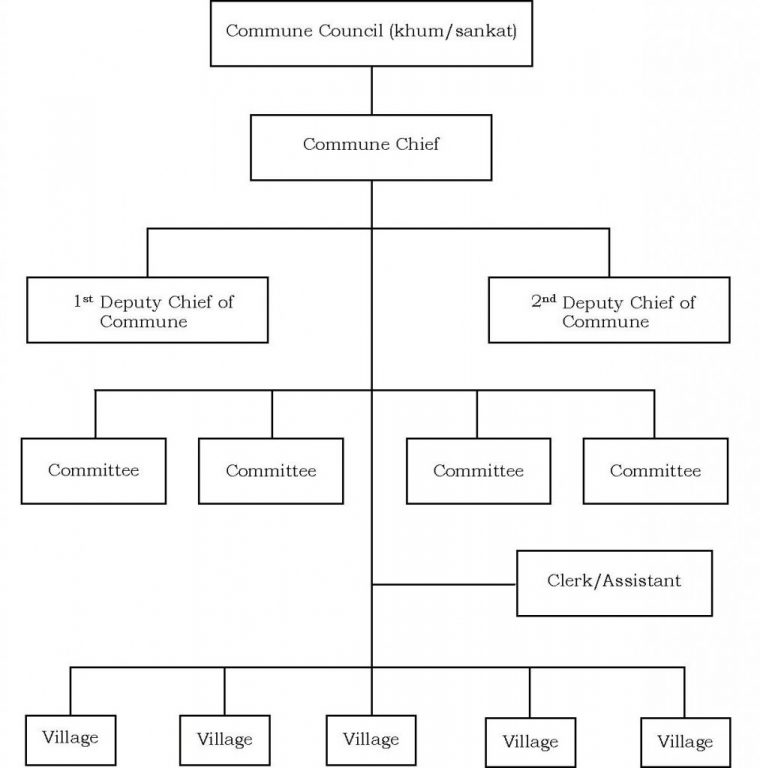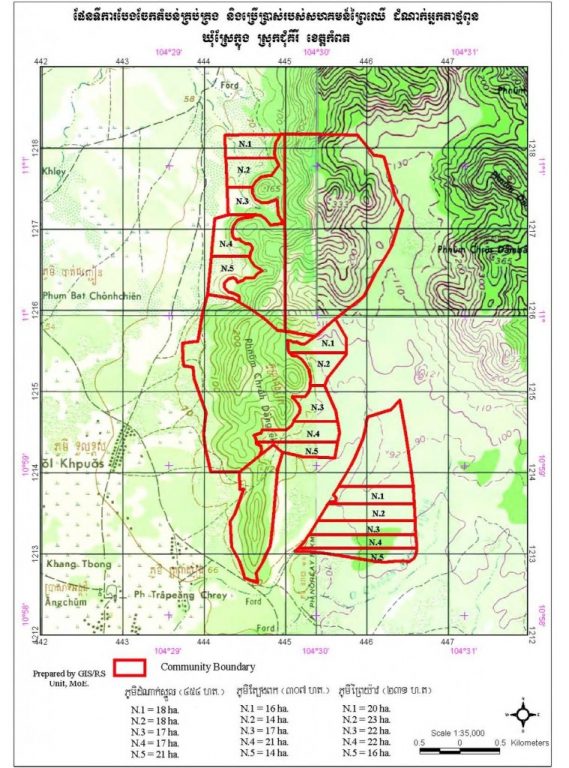Role and involvement of the commune council in community forestry activities in Domnak Neak Tathmor Puan
24.11.2011
-
SUBMITTED ORGANISATION :
-
Ministry of Environment, Cambodia, Community Forestry Research Project (CFRP), CBNRM Initiative, WWF
-
DATE OF SUBMISSION :
-
24/11/2011
-
REGION :
-
South-Eastern Asia
-
COUNTRY :
-
Cambodia (Sre Knung Commune, Chumkiri District, Kampot Province)
-
SUMMARY :
-
On February 03, 2002, the Royal Government of Cambodia held commune/sangkat council elections nationwide. The goal of locally electing community representatives was to improve the implementation of decentralized local development policy and to transfer power from the central level to the local level with clear roles and responsibility. Among the main roles of the commune/sangkat councils is natural resources management. It is considered as one priority, particularly the focus on the establishment of community forestry. Within the community forestry management process, it is necessary to have the involvement of all stakeholders. The commune council is a key stakeholder in facilitating the issues and conflicts occurring. In order to reveal the actual roles and support of the commune council on community forestry activities, a case study was conducted in Srer Knung Commune, Chumkiri District, Kampot Province. The case study emphasized the role and responsibilities of the commune council and village management committee in the process of community forestry development in Domnak Neak Ta Thmor Puan. Moreover, the case study explains the importance of the commune council in legal intervention and describes their responsibility with other competent institutions. The case study describes the direct involvement of commune council members in forest management. According to results from the case study, it is clear that the commune councils play a crucial role in the preparation and implementation process of community forestry. Community forestry activities have been incorporated into the 5-year development plan of the commune under the coordination of the Seila Program. This plan has also been integrated at the district level. Additionally, the whole commune council actively participates in protecting and supporting community forestry. The case study also indicated some constraints and problems even though the implementation of community forestry has been satisfactorily supported by the commune council. Despite the above challenges and problems, the commune councils are actively involved in the community forestry process.
-
AUTHOR:
-
Im Marady Heng Sokla Sok Mary
1. Introduction
On February 03, 2002, the Royal Government of Cambodia held commune/sangkat council elections nationwide, as conducted by the National Election Committee (NEC). The goal of locally electing community representatives was to improve the implementation of decentralized local development policy and to transfer power from the central level to the local level with clear roles and responsibility.
Depending on the population, there are between 5 to 11 council members. Their roles and duties are clearly defined by the Ministry of Interior. Among the main roles(1) of the commune/sangkat councils is natural resources management. This is considered as one priority, particularly focusing on the establishment of community forestry.
Within the community forestry management process, it is necessary to have relations and involvement of all stakeholders. The commune council is a key stakeholder in facilitating the issues and conflicts occurring, and is the community level administrative authority.
What support can the commune council provide to community forestry activities?
In order to reveal the actual roles of the commune council in support of community forestry activities, a case study was conducted in Srer Knung Commune, Chumkiri District, Kampot Province. Two days were spent in the field collecting information. The case study emphasized the role and responsibilities of the commune council and village management committee in the process of community forestry development in Domnak Neak Ta Thmor Puan. Moreover, this case study will explain the importance of the commune council in legal intervention and describe their responsibility with other competent institutions. The case study will describe the direct involvement of commune council members in forest management.
2. Background
Chumkiri is a mountainous area rich in forest products and other natural resources. The forest has provided a range of products to people such as food, water, and wildlife as well as other resources that have long provided sustainable livelihoods to local communities. However, between 1980 and 1998, those forest resources were heavily degraded due to anarchical forest exploitation by both outsiders and insiders. In addition, the cutting, clearance and encroachment on forestland for private titles by a number of individuals has turned the area from a semi-jungle forest to a degraded forest area. The loss of forest cover has caused soil erosion, the loss of wildlife and NTFPs of many species and types as well as made a dramatic impact on the livelihoods of local people.
Being aware of these issues, in 2001, the Community Forestry Research Project (CFRP) and relevant institutions initiated the establishment of community forestry named Domnak Neak Ta Thmor Puan with an area of 992 ha of forestland. CFRP was established jointly by the Forestry Administration of the Ministry of Environment and the Royal University of Agriculture and was funded by the international Development Research Centre and the Regional Community Forestry Training Center (RECOFT). The community forestry area is located in the east along three villages; Prey Yav, Tbeng Pork and Damnak Chnuol in Srer Knung Commune, Chhumkiri District, Kampot Province. There are 596 families with a total population of 2,960 people, of which 1,583 are women.
3. Linkage of Commune/Sangkat Councils within the Structure of the Community Forestry Committee
3.1 Structure of Commune Councils
After the 2002 Commune/Sangkat Council elections all communes within Cambodia set up their own organizational structure to implement their Commune Development Plan. In Srey Knong Commune, Chumkiri District, the organization structure was developed with clear roles and responsibility as below:
The Srer Knung Commune Council has a total of 5 members including:
- One Commune Chief
- One First Deputy Chief
- One Second Deputy Chief;
- Two Members, and
- One Clerk (assistant).
According to the interview, there is a specific division of roles and responsibilities among the members of commune councils as follows:
- Commune Chief is responsible for supervising the overall work in the commune;
- 1st Deputy Chief is responsible for the economic section and natural resources management;
- 2nd Deputy Chief is responsible for security;
- The two Members are in charge of doing a variety of work under the order of the Chief and Deputies; and the
- Clerk assists and does administrative work.
3.2 The Structure of Community Forestry Committee
Similarly, Domnak Neak Ta Thmor Puan Community Forestry elected their own village management committee with specific roles and responsibilities amongst committee members and other members within the community as shown below:
- Group is managed by one Leader and one Deputy, of which Prey Yav consists of 19 groups, Tbeng Pork consists of 15 groups and Damnak Chnuol consists of 10 groups.
- Sub-Committee in each village: three committee members per village (one is a woman);
- Community Committee: consists of five people with 2 women;
- Facilitation Committee: consists of four people (three Village Chiefs and one Deputy Chief of Commune.
Fig. 1: Community Forestry Structure

Besides the above composition, there is another group called the Support Group providing technical support and facilitating the community forestry implementation process. It is composed of CFRP, CIDSE, and competent institutions.
The table below indicates the general roles of the commune councils as prescribed in the Law on Administration and Management of Commune/Sangkat and Natural Resources Management as well as other actual activities which have been implemented within Domnak Neak Ta Thmor Puan CF. The general structure and roles of commune/Sangkat councils are described below:

The commune council and Community Forestry Committee has a very close relationship with clear roles and responsibilities to easily implement their work. Practically speaking, the Community Forestry Committee’s Facilitation Committee consists of three Village Chiefs and the First Deputy Chief of the Commune.
The role of the Facilitation Committee as prescribed in the Domnak Neak Ta Thmor Puan CF’s Statute is to:
- Involve in and facilitate all issues as requested by the Community Forestry Committee;
- Disseminate the activities of the Community Forestry to relevant institutions, local authorities, National and International Organizations;
- Provide advice to the Community Forestry Committee; and
- Involve in the monitoring and evaluation of community activities.
The direct involvement of 1st Deputy Chief of Commune in the community forestry committee is important because he represents the local authority and can be a supporter for the community when there is a problem.
The commune council can play an important role in implementing decentralization of the government which can contribute to good governance. It can be an important institution to carry out commune development work, especially on natural resources management within the commune. However, this process can be successful only if the commune council uses their role to benefit the whole village.
But if they use their power and authority for personal benefit it will cause disbelief among the local population and it will reduce the participation of local people in forest management and even worse, it may cause conflict in the community.
3.3 Legal Intervention:
To effectively succeed in the management of the development process, particularly natural resources management, which mainly focuses on community forestry, it is necessarily to have the support of the local authority and competent institutions. There we can consult and discuss in order to ensure that our activity is smoothly implemented and problems or conflicts can be effectively resolved. Logically, the community forestry implementation and operation can be successful if it has the support of local authorities from provincial to commune levels. Particularly, the 1st Deputy Chief of Commune plays an important role as part of the Facilitation Committee in the community forestry organizational structure.
In the Facilitation Committee, he has many important roles including solving land conflicts within his village or commune as well as other community forestry related issues. He is involved in resolving conflicts when demarcating the community forestry boundary and resolving conflicts over boundaries impacted on some villagers’ land where they used to cultivate crops. Consequently some villagers are not willing to contribute their land as common property.
|
1st Deputy Chief, Sous Neb, talked about the boundary demarcation: “Regarding the impact on villagers’ land, when I was doing the boundary demarcation, I dealt with the conflicts by referring to the relevant law and some guidelines. For instance, after the commune integration in 1995-96, there was an internal guideline to allocate some areas of land (50 m x 100 m) for people and the land to be provided to people should be 150 m away from the mountain. The allocation was effective for three years and then, if the land was not used within the limited period, the land will be assumed as common land again. I also explained that I put the land under the community forestry protection not for my own benefit but it is for the benefit of everyone who lives in the village and we will continue to conserve it for our younger generation.” Sous Neb, 2003. |
After the establishment of community forestry, offences have gradually decreased because the community has become aware of their roles and responsibilities as community members. They became aware through meetings, the dissemination of legislation and laws on forestry and land. In addition, the community forestry statute, management plan, regulation and community forestry concepts have also been disseminated. Although most understand, there are still some offenders, most of them people from outside the village. Due to the facilitation effort of the 1st Commune Deputy Chief and through extension activities the number of offences has been continually reduced.
|
Mr. Tep An, Chief of the Community Forestry Committee, stated that in mid 2002, he caught three ox carts of people who came into the community forest area to cut forest for firewood, these people come from Tram Kok district, Takeo province (located on the Takeo and Kampot boundary). He asked them why they were cutting the forest in the area? Do you know it is the community forest area? He read them the relevant articles in the statute. They replied that they knew a little about the area but that it was their habit and tradition to collect firewood in the area. They did not know that there is a strict law and regulation like this in the area. After questioning them, we advised them and confiscated the evidence for common use in the community. Tep An, 2003 |
Apart from the facilitation, the commune councils are also involved in other activities, by acting as advisor to the committee and sub committee concerning technical issues and management. Regarding the technical support, the commune council normally helps the community committee and sub-committee by additionally explaining any points or issues which they did not clearly understand or when the issues were beyond their capacity to understand. They have assisted when community members were invited by an organization or project for training courses or study tours.
One among many activities is signing the approval and recognition of the community legal procedures including the CF by-laws, CF management plan, CF regulation and CF agreement (for future use). It is clear that the smooth and successful implementation of community forestry is the result of strong support by the local authority, particularly the involvement of the commune councils in all activities.
According to the case study interviews, the Community Forestry Committee declared that they are satisfied with the support of the 1st Commune Deputy Chief for all community forestry activities. Most problems or conflicts were resolved at the communal level. Up to now, there is no single problem that cannot be resolved by the commune council.
4. Linkages with Other Institutions and Extension Activities
Cooperation is an important factor to promote sustainable development, namely in working with the competent institutions and other organizations trying to achieve similar goals. Similarly, community forestry implementation requires support and cooperation by relevant institutions.
In terms of cooperation, the community has worked closely with stakeholders. Mr. Tep An, community committee chief, stated that community forestry activities have been integrated into the 5year development plan of the commune under the facilitation of Seila and the plan has been integrated with the district plan. He added that more cooperation is needed when there is conflict or any offence that cannot be resolved by the community (conflict with military over land). Then we have to negotiate or coordinate with leaders of the institution or send the case to the provincial level in order to ensure the process can go smoothly and effectively. Mr. Tep An has widely disseminated information to outsiders about issues related to community forestry, and now, the number of offences has been greatly reduced.
Another significant factor is that the agency CIDSE is working in Chumkiri District of Kampot Province through its development program. It has cooperated and helped to disseminate CF related issues to people, particularly during the community cluster meeting or village planning meeting. In the meeting agenda, they always raise the topic of community forestry activities for discussion.
CIDSE staff working in the area echoed the comments of Mr. Yen Oun, “the commune/Sangkat councils have close cooperation with the district level because the district is a strong supporter for conveying information or coordinating issues with the provincial level or relevant competent institutions”.
Apart from working as the 1st Commune Deputy Chief and member of the Facilitation Committee, Mr. Sous Neb has actively participated in community forestry activities as a citizen of Prey Yav village. He has mainly been involved in directly building a fire break, meeting to discuss the statutes and management plan, selecting the Community Sub-Committee and Committee, monitoring and evaluating implementation and participated in meetings and discussions related to community forestry.
However, not all members of the community participated to benefit all the people. Some people used their role to protect illegal forest activities (transferring wood from a nearby village) which affected community organizing. Now, some of the community members are less interested in community forestry development.
5. Conclusions
According to results from the case study, it is clear that the commune councils play a crucial role in the community forestry preparation and implementation process. This is because the commune councils have defined roles and responsibilities for each member. Officially, the Srer Knung Commune Council has specifically assigned Mr. Sous Neb, 1st Deputy, to be responsible for natural resources management, particularly Domnak Neak Ta Thmor Puan community forestry.
More significantly, the involvement of the 1st Deputy Chief in the Community Forestry Committee (Facilitation Committee) is helpful in strengthening the implementation of law. Because he represents the local authority, and is the main supporter of people when they face any problem he is able to resolve other conflicts as well. He always discusses and consults with the commune council or relevant institutions when he wants to make any critical decision.
It should be noted that the whole commune council participates actively in protecting and supporting the community forestry. Additionally, community forestry activities have been incorporated into the 5-year development plan of the commune under the coordination of the Seila Program. This plan has also been integrated at the district level.
The case study indicated some constraints and problems even though the implementation of community forestry has been satisfactorily supported by the commune council. This is because the commune councils are overworked, lack materials and finance and have limited capacity. These are barriers to effectively achieving other activities in the commune.
On the other hand, using their role in an appropriate way helps to accelerate community organizing and gain support from the community members. But if the commune council use their role for personal benefit, it will cause local people to lose their attention and limit their participation in the community development process.
In summary, the commune councils still have some constraints and problems to overcome such as:
- No neutrality;
- Limited capacity;
- Not enough rights and freedom;
- No appropriate working space; and
- Lack of means for travel.
Despite the above challenges and problems, the commune councils are willing to be actively involved in the community forestry process.
6. References:
- Kim Sarin, 2003, Case Study on the perception of community members and stakeholders of Domnak Neak Ta Thmor Puan Community Forestry, Srer Knung Commune, Chum Kiri District, Kampot Province. Documents prepared by CFRP.
- Facilitation Team of CFRP based in Chumkiri District, 2002. Statute of Domnak Neak Ta Thmor Puan Community Forestry. Documents prepared by CFRP.
- Facilitation Team of CFRP based in Chumkiri District, 2002. Community Forest Management Plan of Domnak Neak Ta Thmor Puan. Documents prepared by CFRP.
- Law on Commune/Sangkat Administration and Management, 2002.
7. Appendixes
Appendix 1: Commune Council Organization Chart

Appendix 2: Important Laws on Commune Councils related to Natural Resources
Article 41:
The commune administration has duties to promote and protect good governance by managing the use of available resources without limited time in order to meet the basic needs of its commune (khum/sangkat) for the common interests of the citizens and to respect national interests in conformity with the state’s general policy.
Article 43:
Regarding the role of local affairs, the commune administration has duties to:
– maintain security and public order;
– k-manage public services as necessary and be responsible for the good process of those services;
– encourage the creation of contentment and welfare of the citizens;
– promote economic and social development; and upgrade the living standard of the citizens;
– protect and conserve the environment, natural resources, culture and the national patrimony;
– coordinate the citizens’ view in order to promote tolerance and mutual understanding;
– perform general affairs in response to the needs of citizens.
Article 63:
In preparation of the commune development plan, the commune council shall take the following steps to:
– evaluate the existing level of development and development activities in its commune (khum/sangkat);
– assemble all needs of the commune and prioritize all those needs based on available resources of the commune (khum/sangkat) and other acquired resources;
– prepare programs which may respond to these needs through providing services and development. And all these programs must be included in the annual budget of the commune (khum/sangkat);
– deliver sevices and development in accordance with its budget;
– control, monitor and evaluate the implementation results of the development plan;
– use the results to evaluate the level of new development in its commune (khum/sangkat);
– make reports on the implementation results of commune development plan and introduce them to the citizens in its commune.
Article 66:
The commune council shall monitor, control and evaluate the implementation of the plans, programs, projects and the delivery of services with transparency and high accountability.
Article 67:
The commune council remains accountable for the follow-up, control and evaluation of the plans, programs and other projects, even though such works are implemented by whichever component chosen by it.
Appendix 3: Map of Community Forestry in Domnak Neak Ta Thmor Puan

Appendix 4: Integrated Natural Resource Management in to Commune Council Plan
- Prey Yav Village Development Plan 2004:
v Objective 2: to improve food security and resource management for the poor.
– Improve tree nursery
- Tbeng Pok Village Development Plan 2004:
v Objective 2: to improve food security and resource management for the poor.
– Continue to raise awareness on natural resources management
– Strengthen sub-committees
– Organize study tour for natural resources management sub-committees
– Advocacy for natural resources management
- Domnak Snoul Village Development Plan for 2004:
v Objective 2: to improve food security and resource management for the poor.
– Awareness raising through meetings on natural resources management
– Strengthen sub-committees
– Provide a training course for sub-committee and head of natural management groups.

